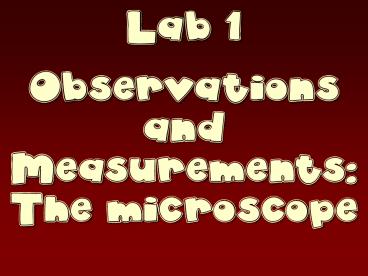Lab 1 PowerPoint PPT Presentation
1 / 46
Title: Lab 1
1
Lab 1 Observations and Measurements The
microscope
2
(No Transcript)
3
Nikon Eclipse E200 Biological Microscope
4
Revolving Nosepiece
5
(No Transcript)
6
(No Transcript)
7
2
Loosen Nut
1
4
Tighten Nut
3
8
Eyepiece Tube
9
Focusing the condenser
To focus the condenser, place the sharpened end
of a pencil on the halogen light source The
condenser can be raised or lowered by a knob
below the stage of the microscope
10
Low Position
High Position
Bring the pencil point into focus
11
Before putting a slide on the stage Make sure
that the stage is in the lowest position, and
revolve the nosepiece to the scanning objective
(4X)
Move the specimen slide clip as shown in the next
diagrams
12
Clip Release
Slide Holder
Specimen Slide Clip
13
This is a spring-loaded arm, not a stage clip!
This arm holds the slide in the corner of the
slide holder
14
One corner of the slide goes here
15
Pressure from the spring-arm holds the slide in
place
16
Using the oil objective
1. Bring the object into focus up through high
power (400X)
2. Revolve the nosepiece to the oil objective
WITHOUT PUTTTING OIL ON THE SLIDE YET!
17
Oil objective lens now in position
18
These microscopes are equipped with a refocusing
stage The stage can be instantly dropped by
pushing it down manually to oil the slide, then
returns to its original position as soon as the
hand is removed
19
Push down gently on the stage with one hand
Apply oil to the slide with the other hand
20
(No Transcript)
21
When you are finished with the oil objective,
lower the stage to its lowest position using the
coarse focus knob Do NOT revolve the nosepiece
to another objective through the oil that is on
the slidethe other objectives will become
contaminated!
22
Once the stage is in its lowest position, use
lens paper to clean the oil from the oil
objective, and remove the oily slide from the
stage The slide can be cleaned with Windex or
soap and water
23
Microscopy involves three basic concepts
- Magnification The degree to which the image of
a specimen is enlarged
- Resolving Power How well specimen detail is
preserved
- Contrast The ability to see specimen detail
against its background
24
Calculating Total Magnification
The eyepiece lenses are 10X
To get the total magnification, we multiply the
power of the eyepiece (10X) by the power of the
objective lens we are using
Eyepiece Objective Total Magnification
25
Our scanning objective is 4X Calculate the total
magnification when using this objective
10X 4X 40X
When using the scanning objective, total
magnification is 40X All other magnifications can
be calculated this way
26
Measuring the Diameter of the Field of View
It is possible to get a rough estimate of the
size of an object by measuring the field of view
with a transparent scale under scanning power
27
Measuring the Diameter of the Field of View
1 mm
About 0.2 mm
28
So
This is our approximate field of view when using
the scanning objective
We can use this information to get a rough
estimate of the size of the objects we are viewing
29
If this is our object, and our field of view is
about 4200µm, this object is between 900 and
1000µm
30
In order to calculate the field of view for
magnifications beyond that of scanning power
(40X) , we must use the following equation
31
y the unknown diameter (in µm) of the field of
view sp the magnification of the scanning
power d the diameter (in µm) of the scanning
field of view m the magnification of the
unknown field of view
32
Once we have a rough measurement of the field of
view under the scanning power, we can use our
equation to calculate the field of view under any
of the other magnifications
Most of our compound microscopes have a scanning
field of view of between 5000 and 5300 µm
33
(No Transcript)
34
So, our field of view when using 400X
magnification is 520µm in diameter Note that the
numerator becomes a constant The only thing that
changes once the scanning power FOV is determined
is the magnification in the denominator
35
Calibration of the Ocular Micrometer
The ocular micrometers on these microscopes are
not scaled The divisions do not correspond to
any particular measuring system
36
Therefore, the ocular micrometers must be
calibrated to a stage micrometer of known metric
value. In this case, the stage micrometer is
1.0mm from end-to-end, and each single division
is 0.01mm
37
One end of the ocular micrometer and stage
micrometer must be lined up and overlapping. Then
we look for the next division where both scales
overlap againThis is where we find what the
ocular scale is in millimeters
38
(No Transcript)
39
(No Transcript)
40
If, for instance, four divisions on the ocular
micrometer correspond to ten divisions on the
stage micrometer, we can calibrate the ocular
micrometer as follows in the next slide
41
- 10 divisions on the stage micrometer 0.1mm
OMD Ocular Micrometer Divisions
42
What is resolving power?
This is the ability to distinguish two closely
spaced objects as two rather than one The
smaller the distance between two objects that can
be distinguished from one another, the better the
resolving power
43
Resolving power (R) is dependent on three factors
- Angular aperture (?)
- Refractive index (n)
- Wavelength of light (?)
44
The value of R can determined by the expression
Where NA is numerical aperture
45
Skip Extending Your Investigation Measuring
Cyclosis on page 10 of the lab book Continue on
with exercise D on page 11
46
Web Resources
Biol 196 Course Webpage
http//faculty.unlv.edu/payettea/Biol196/
Nikon Microscopy Website
http//www.microscopyu.com/sitemap.html

